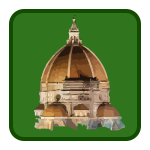Today I did a marathon trek through Rome. You may be thinking — that’s a lot of miles — and you’d be right (if talking in KMs). It wasn’t an actual marathon, but it was such an endurance challenge that it felt like one.
I’m starting the habit of leaving early whenever I go somewhere and don’t have to drive it myself. Today’s travel was by train in a short, less-than-two hour trip. The best part about these train rides: I got to sleep! I arrived in Rome at 9:30 and immediately set off on my whirlwind tour of the city. My first debacle was to decide which Metro pass to purchase. I solved it by getting a 24 hour pass with unlimited passages. (I think, in all, I saved 4 euros just by doing that).
I started the day with a list of things I wanted to see. They were all recommended to me by Father Jack of some of his favorite places from when he served in Rome. My first stop was St. Paul’s Outside the Walls. This basilica is the second largest in Rome (20 points if you know what the largest is!). If it’s the second biggest in the center of the Catholic church, you know it’s big! At the front of center nave were two statues: one on the left of St. Peter holding the keys to heaven, and one on the right of a balding (I know -comforting) St. Paul caught in a moment of looking stern while holding a sword. Overall the church was less intricate than many others I’ve seen. There wasn’t much in sides that distracts the attention from the center-front. Another great thing was the quality of its cloisters. It’s probably due to the rain, but the colors of the grass and flowers were SO bright. I can’t imagine taking breaks from classes (or worships) in those places — I wouldn’t want to go back.
The second stop was four Metro-stops down and a nice walk: Tre Fontani. This place of three fountains is set up as the site where Paul was beheaded. At first I couldn’t find it, but did find what Jack correctly called a “low-key” Marian shrine. This place was where Mary appeared to a communist; low-key is somewhat of an understatement. I walked up and all I could see was a tent around this grotto. It was only when I went inside of the tent, I saw that in it was a building around the shrine; still, definitely low-key. From there, I got directions to the Tre Fontani.
The highlights of the Tre Fontani were the signs. Call me irreverent, but knowing that it was the place where an event happened almost two millenia ago wasn’t as interesting for me as how it is treated today. The signs told it all! The site is set up for pilgrims and includes the trigger for the mind of a long and winding driveway into it to symbolize a greater amount travelled (think the first entrance to the Christian Conference Center and you understand). Before even starting on the driveway I read a sign in five different languages: “This is a sacred place where one venerates the memory of the martyrdom of the Apostle St. Paul. Visitors are welcome and kindly requested to behave conformly to the obvious rules of a holy place.” Walking about 20 meters on the driveway I came upon a statue of (who I think was) St. Benedict holding his right index finger up to his lips. I LOVED IT — for those who can’t read, the statue tells you enough. “The obvious rules of a holy place” are made obvious by the statue demonstrating it. Making my way past a building that looked like a monastery, I followed a path through a grove of trees to a little chapel at the end. Keep in mind that it was raining (A LOT) and the trees didn’t offer much of a canopy from the storm. I made it to the chapel and was hit by something I hadn’t heard (pun intended) in a while: silence. Most churches I enter have acoustics that echo a lot of the sounds: this one had them where it ripped them from the air: the two other people in the chapel walking around didn’t make a sound, even though the way they were walking probably should have. The chapel was beautiful. Behind the altar was a painting (which, I need to check – but I’m pretty sure was a Caravaggio — in either case: a baroque) that I think was actually the martyrdom of St. Peter (surprising since it wasn’t his site). The figure was being crucified upside down and was bending up and looking above at his feet. Like I said, I’ll need to check. The sign on the way out of the site was hilarious: Trappist Liquors for sale. That explained the quietness — not much else though! 😉
When I finished it was 1pm and I knew there was a chance some of the other places I wanted to go would be closed for siesta — so I went somewhere that I knew would be open: St. Peter’s. (For those wanting the 20 points, you should have guessed this one!) St. Peter’s was better the second time; I stood in line, and in the cathedral, for two hours. Like the last time, the building is still as huge and as impressive when you first walk in. Different from the last time, however, the sun wasn’t shining in the windows. I like it SO much better darker. It’s much more difficult to get good pictures, but the shadows behind all of the statues give them more emotion. The mosaic giant duplications of the great works (i.e. Raphael’s “Transfiguration” – my favorite) don’t look as good with the artificial lighting, but the rest seems even grander.
After St. Peters, I went to the Gesu. The Gesu is the mother church of the Jesuits (the Society of Jesus – a Catholic male monastic order founded on the Spiritual Exercises of St. Ignatius of Loyola). Many consider the Jesuits one of the more progressive orders of the Catholic church; the thing I saw in the Gesu definitely shows that. After entering I saw there was a large group of people at the front in the side chapel. I know that “tourist” visits aren’t allowed in churches during religious celebrations, so I looked, but didn’t see a priest or anyone officiating. It was a large group of people doing private devotions!
I sat in the back of the church and let it all soak in. Looking at the ceiling I heard something familiar and recognized the melody of the film “The Mission,” which is about South American Jesuits in the late 1700’s. I looked over to my right to see where it was coming from and WHOA — there was a giant widescreen flat-panel television in one of the small chapels along with a display on St. Ignatius and the Society. When I went over and looked, I also saw the display for St. Francis Xavier, giving information on his life. Apparently it’s the 400th Anniversary of something Xavier did (I’m not sure if it was his departure for India, his birth or what — I should probably check on that). After looking at those, I went back to sit down and just admired the ceiling. The ceilings and sides and fronts of all Baroque churches are amazing, this one included.
After going to the Gesu, I went to another Jesuit church: St. Ignatsio. I’d visited this church the first time I went to Rome, but I had to go back (it’s like St. Peter’s). Actually, it’s like it in so many ways: both are baroque, both are huge, and both look SO different with altered lighting. I didn’t like St. Ignatsio nearly as much as I did the first time. The lack of sun shining through the windows caused them to artificially light some of the areas: unconvincingly. I’m not sure if it was the type of bulbs they used or what, but compared to St. Peter’s and the Gesu, St. Ignatsio’s lighting didn’t have the warm glow of the others: it was a cold and artificial light. In any case, I still LOVE the ceiling frescos and made sure to get a better shot than I did the last time: this time — I did a 30″ exposure! For those familiar with cameras, it was at f22 with a 100 ISO. The result is incredibly clear and is really pretty to zoom up close in on the computer.
What I liked best about this visit was the time factor. I wasn’t being rushed around by others; I could visit at my own pace. With St. Ignatsio, I spent 20 minutes just sitting, praying and studying the frescos at the front of the sanctuary that I hadn’t even noticed the first time I came. Unfortunately the rain did make the entire trip cold and wet
. I also wasn’t able to make it to the Scavi or the Catacombs — but those are on the list for the next time I come to Rome. The return trip to Florence this evening was fun: especially since I got to catch up on sleep some more. The act of not transporting yourself is incredibly liberating; we’ll see if I say the same thing when I drive down to Ft. Worth in 13 days.








Speak Your Mind
You must be logged in to post a comment.